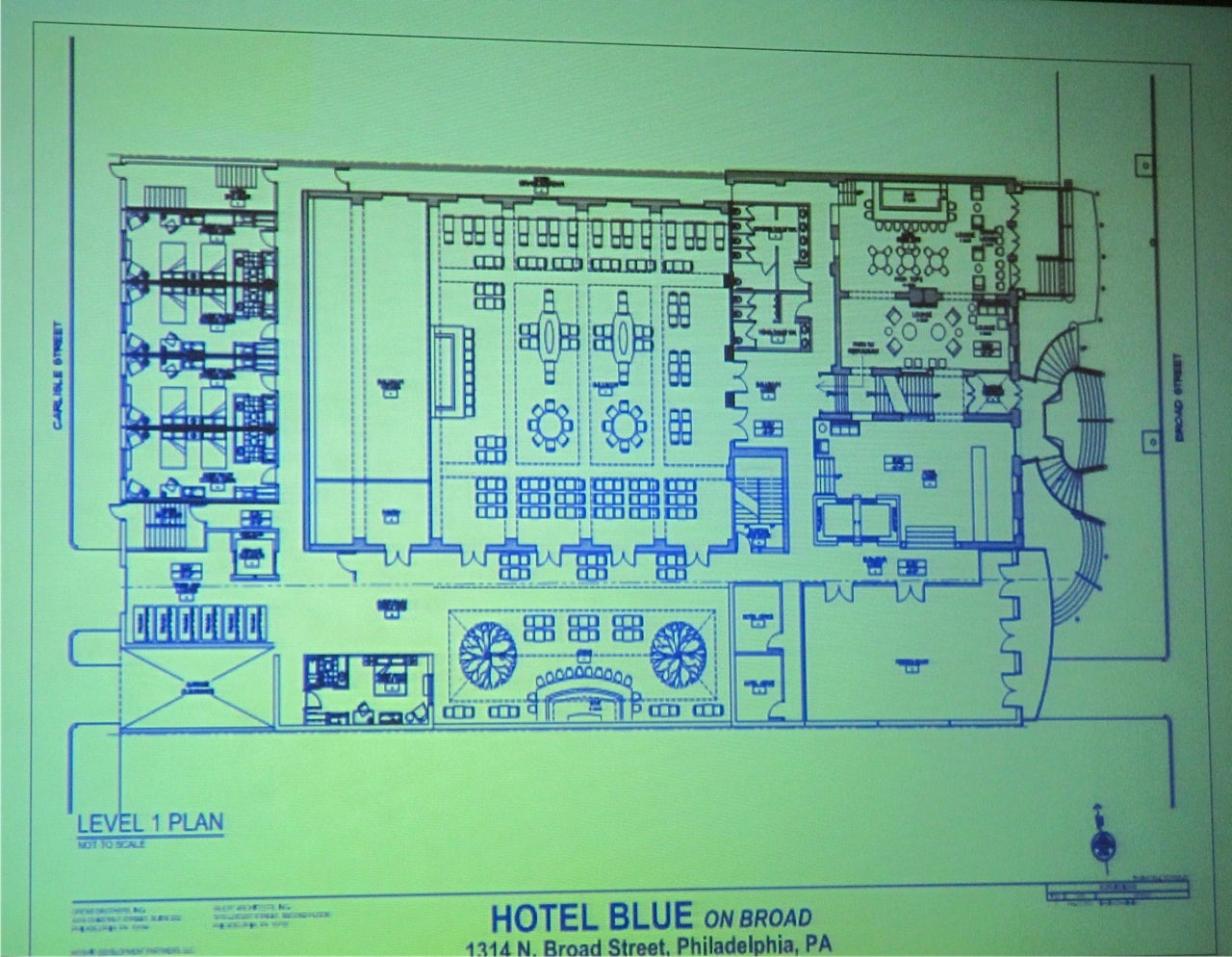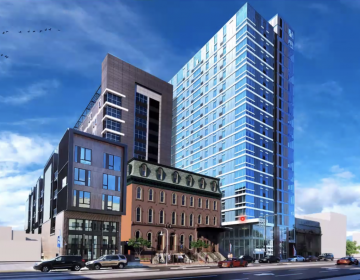Will iconic Broad Street boxing venue get new life as boutique hotel?

The Blue Horizon, a legendary former boxing venue on North Broad Street, may be reborn as The Hotel Blue on Broad, a boutique spot with restaurants, a jazz club, and some nods to its past lives.
Mosaic Development Partners and their architect, historian and other experts described their plan for Hotel Blue on Broad to the Philadelphia City Planning Commission Tuesday. Mosaic principal Leslie A. Smallwood-Lewis said the $28 million hotel would have 87 rooms, including 12 suites in the historic former mansions that make up the Blue Horizon, at 1314-1316 N. Broad. The developers have received a $6 million state redevelopment grant.
Other rooms would be housed in a new, 8-story addition to the building that would be built on the footprint of 1310 N. Broad. That building, now home to performance venue and catering hall Dowling’s Place, would be torn down, said project attorney Darwin Beauvais. Dowling’s owner would move to a supper-club like space below grade in the new hotel, Smallwood-Lewis said.
The operator of the larger restaurant has not yet been determined, Smallwood-Lewis said after the meeting.
About 1,500 boxing fans could watch bouts at The Blue Horizon before it was shuttered in July 2010. Some of this space would be used for hotel rooms, and the reborn multi-purpose room could hold between 800 and 900.
Those walking into the hotel would use the large, semi-circular staircase on Broad Street. Drivers would pull into a covered car lane to drop off passengers or use valet parking. There is no parking on site, but Mosaic is negotiating with property owners nearby, and is also working out agreements to use Temple University parking facilities for its largest events, Smallwood-Lewis said.
The property would be the first Ascend Collection Hotel in Philadelphia, Beauvais said. According to the company website, Ascend Hotels, affiliated with Choice Hotels, focus on “historic” or “unique” properties with “strong local flair.” The site is close to Temple University’s main campus. Under an agreement with Temple, school of hospitality students would work at the hotel as interns, giving them real-life experience that would help Temple market their program. It would create 86 permanent jobs.
The history here goes beyond boxing, Smallwood-Lewis said. The Blue Horizon began life in 1876 as three mansions. The center one was owned by the Stetson family. Moose International bought the mansions in the early 1900s, and they became the largest Moose lodge in the country, she said.
The building is not on the local historic register, Smallwood-Lewis said, but the development group has been working with the Pennsylvania Historical and Museum Commission in hopes of landing it on the National Historic Register. Mosaic would like to start construction in the fall and open in 2014.
“It’s very exciting,” Commission Vice Chairman Joseph Syrnick, who ran Tuesdays meeting, said.
But he and several other commissioners had questions for the team, and indicated they had a lot of work to do to solidify answers in time for the commission to vote on the proposal at next month’s meeting.
In order to be built and operate as planned, the project needs relief from several zoning provisions. Attorney Beauvais said the underlying zoning would need to be changed from its current C2 to C4 – still commercial, but allowing higher density uses. The parcels currently have no on-site parking, and while the developers are working on leasing or purchasing nearby lots, parking requirement relief is also needed. The developers also want a curb-cut on Broad Street, allowing cars to enter a covered structure for valet and guest drop-off. What the commission would actually be voting on is whether or not to support legislation introduced by City Council President Darrell Clarke that would grant that relief. Beauvais said Clarke has introduced one version, but “we are working on an amendment to address the new zoning code.” Beauvais showed letters of support from the Avenue of the Arts and Temple.
Commissioner Brian Abernathy asked why the developers were seeking relief via city council ordinance rather than going through the Zoning Board of Adjustment. Beauvais said that no one was trying to circumvent the community participation that comes along with the ZBA approach. But potential lenders would be more comfortable with legislation. (ZBA decisions can be appealed in the courts).
“Have there been community meetings with residents?” Commissioner Nilda Ruiz asked. They are in the works, the team said.
Abernathy was puzzled by the parking plan. Current requirements call for one parking space for every two hotel rooms, but most hotels opt to provide more, not less, he said.
The team said that the hotel is located near public transportation, and listed several nearby lots that they are working to purchase, lease, or reach parking agreements with.
Commissioner Nancy Rogo-Trainer had concerns about the materials that would be used to build the new building addition, where the bulk of the hotel rooms would be. She wished the Philadelphia Historical Commission had oversight. They do not, because the building is not on the local historic register.
Those working on the hotel said they have reached out to the commission for input, however, and they have been working closely with the Pennsylvania Historical and Museum Commission, the state agency helping them in their efforts to be listed on the national historic register.
Original plans called for the new building to stretch entirely to Broad Street, but the PHMC said that would detract from the historic facades of the original mansions. There is now a setback. Architect David Schmauk pointed out a slated atrium wall between the old and new buildings. Yes, it would bring light into the hotel, he said, but it would also serve as a visual separation between the old and new buildings, and allow the preservation of the mansard roof.
The new building would not copy the exact brick and stone materials used in the mansions, Schmauk said. Instead, “modern” materials – cast stone – would nod to the colors and style on the lower level. Higher up – and in an L-shape to the side and back of the existing structure – stucco would be used.
Rogo-Trainer wasn’t fond of that – especially not facing Broad Street. “It’s really an important place,” she said. “I would encourage use of modern, but quality materials, at least on Broad Street, so it doesn’t look like a hotel from the suburbs.”
After the meeting, Smallwood-Lewis said in addition to bringing the former boxing venue/mansions back to some of their original splendor, the project would highlight the important impact the site had on African-American history and culture in Philadelphia in other ways. This might include historic photographs and murals on what was shown to be a blank wall on one side of the building. The existing mural will remain, she said.
Reach the reporter at kgates@planphilly.com
WHYY is your source for fact-based, in-depth journalism and information. As a nonprofit organization, we rely on financial support from readers like you. Please give today.




